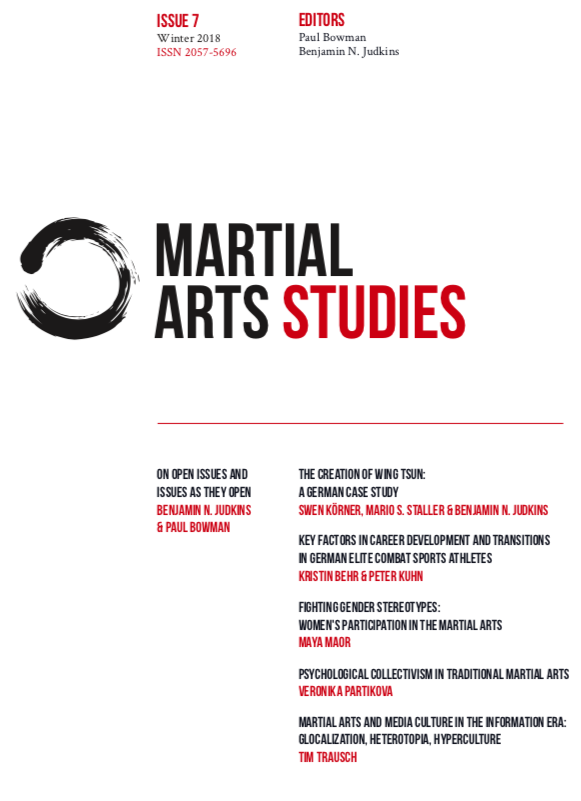
We are happy to announce that the seventh issue of Martial Arts Studies is now freely available. Martial Arts Studies is the premier scholarly source for interdisciplinary work on a wide variety of topics surrounding the practice, sociology, history and media representation of the modern combat sports and traditional martial arts. Published twice yearly, we are dedicated to presenting the very best research written and reviewed by leaders in the field.
This issue begins with an editorial followed by five articles and three short reviews. Judkins and Bowman start by discussing what an “open issue,” such as this, suggests about the current state of Martial Arts Studies. They note that the current issue stretches our discussion of the Asian martial arts in geographic terms, while also asking us to consider the many complex interactions between physical practice and identity formation.
In the first article, “The Creation of Wing Tsun – A German Case Study,” Swen Koerner, Mario S. Staller and Benjamin N. Judkins take a detailed look at the global spread of Wing Chun. Ip Man’s immigration to Hong Kong in 1949, followed by Bruce Lee’s sudden fame as a martial arts superstar after 1971, ensured that wing chun kung fu, a previously obscure hand combat style from Guangdong Province, would become one of the most globally popular Chinese martial arts. Yet this success has not been evenly distributed. Despite its cultural and geographic distance from Hong Kong, Germany now boasts a number of wing chun practitioners that is second only to China. Their article draws on the prior work of Judkins and Nielson [2015], as well as on systems theory and local historical sources, to understand why this is the case.
Next, Kristin Behr and Peter Kuhn examine the “Key Factors in Career Development and Transitions in German Elite Combat Sport Athletes.” The purpose of their study was, through in-depth interviews, to systematically identify key factors that facilitate and constrain career development and career transitions. Their findings relate to difficulties and critical events in athletes’ attitudes toward their career development. They conclude that an athletic career is a highly complex, multi-layered, and individual process. Significant differences were found between statements of student-athletes and “sports soldiers” within the German system. Participation at senior competitions at an early age is required for a smooth transition to a world-class level.
The third research article, “Fighting Gender Stereotypes: Women’s Participation in the Martial Arts, Physical Feminism and Social Change“, by Maya Maor, explores the unique social conditions that make full-contact martial arts a fertile ground for gender subversive appropriation in terms of: 1. close and reciprocal bodily contact between men and women, 2. the need to learn new regimes of embodiment, and 3. the paradoxical effects of male dominance in the field. Maor describe two specific mechanisms through which subversive appropriation takes place: formation of queer identities and male embodied nurturance. While the first mechanism relies on women’s appropriation of performances of masculinity, the second relies on men’s appropriation of performances of femininity.
Veronika Partikova continues the ongoing discussion of martial arts and identity formation in her piece “Psychological Collectivism in Traditional Martial Arts.” Her paper offers a new perspective for viewing traditional martial arts in terms of psychology. It argues that ‘traditional’ martial arts offer physical skills, moral codes, rituals, roles, and hierarchical relationships which, taken together, creates the perfect environment for psychological collectivism. Psychological collectivism focuses on individuals and their abilities to accept the norms of an in-group, understand hierarchy, and feel interdependence or the common faith of the group. First, this paper introduces the theory of psychological collectivism and connects it with traditional martial arts known as wushu or kung fu. It argues that traditional Asian martial arts create situations strong enough to activate collectivistic attributes of self and suggests that practitioners’ mind-sets can be different within and outside of the training environment. This kind of collectivistic interaction may provide one explanation for how non-Asian practitioners function in such training environments and how the traditional Asian martial arts can work as psychosocial therapies.
The final research paper is contributed by Tim Trausch. “Martial Arts and Media Culture in the Information Era: Glocalization, Heterotopia, Hyperculture” is derived from the Editor’s Introduction to the collection Chinese Martial Arts and Media Culture: Global Perspectives [Rowman & Littlefield International, 2018]. This volume explores how narratives and aesthetics of the martial arts genre(s) are shaped and imbued with meaning in changing social, cultural, and media arrangements. Drawing from a range of recent media texts, this introductory chapter discusses the global circulation of signs and images of (Chinese) martial arts and their engagement with alleged national, cultural, textual, generic, and media borders. It argues that these texts reflect and (re)produce three paradigms of martial arts and media culture in the information age: glocalization, heterotopia, and hyperculture. What connects these three notions is that, rather than erase difference or establish it as something substantial and dividing, they engage with difference and otherness in inclusive and transformative ways.
The issue closes with three reviews. First, Andreas Niehaus, Leo Istas and Martin Meyer report on the “8th Conference of the German Society of Sport Science’s Committee for Martial Arts Studies.” It took as its organizing theme “Experiencing, Training and Thinking the Body in Martial Arts and Martial Sports.” Next Spencer Bennington reflects on Udo Moening’s volume, “Taekwondo: From a Martial Art to a Martial Sport.” Finally, Qays Stetkevych provides a candid review and close reading of the recently released “Martial Arts Studies Reader” [Rowman & Littlefield. 2018].
As always, this issue is freely available on-line. Or visit our webpage to learn more about this publication and to find our call for papers.
oOo
Do you still need to catch up with Issue 6 of Martial Arts Studies? If so click here.
oOo
